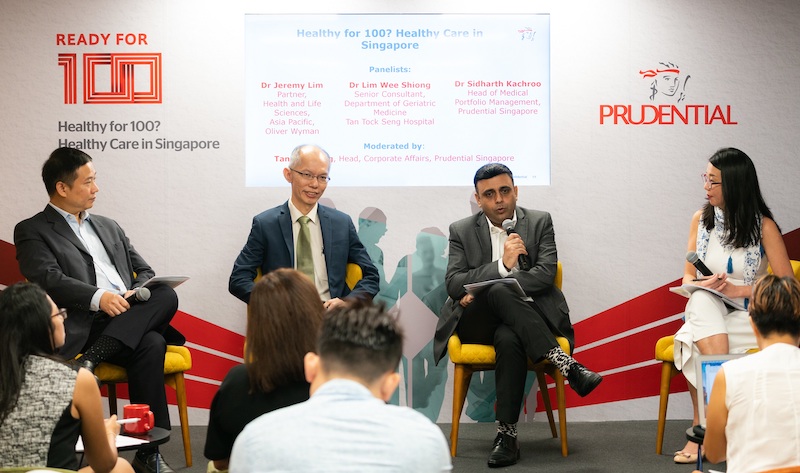Healthy for 100?
Healthcare professionals say we will have a hard time coping with health-related expenses and prevention is the key.
 Nearly half of healthcare practitioners feel Singaporeans will be hard-pressed to cope with the health-related expenses of living to 100 as a greater number of them will need to manage more than one chronic disease in their old age, according to a Prudential survey conducted and researched by the Economist Intelligence Unit (EIU). In a separate survey by EIU, 55 percent of residents said they were not ready from a health and wellness perspective to reach 100.
Nearly half of healthcare practitioners feel Singaporeans will be hard-pressed to cope with the health-related expenses of living to 100 as a greater number of them will need to manage more than one chronic disease in their old age, according to a Prudential survey conducted and researched by the Economist Intelligence Unit (EIU). In a separate survey by EIU, 55 percent of residents said they were not ready from a health and wellness perspective to reach 100.
Singaporeans are ageing rapidly and living longer. By 2035, 28.6 percent of Singaporeans will be 65 years and older, double the figure from 2015 and by 2019, average life expectancy will stretch to 84.8 years, an increase from 1997 when it was 76.9 years. This demographic change will bring its set of challenges. The average number of years living with disability will increase, and there will be a rise in people having more than one chronic disease. Currently, over half of those older than 60 have more than one chronic condition.
Prudential Singapore CEO Wilf Blackburn said: “As medical costs continue to rise, we must evaluate the role we can play in making healthcare more affordable and accessible. As insurers, this means changing the way we engage with customers. We want to go beyond covering their medical bills to coming up with innovative solutions to help them live well for longer. Staying healthy is the best strategy to keep one’s medical expenses low in the long run.”

From left to right: Dr Jeremy Lim, partner, Oliver Wyman; Prof Lim Wee Shiong, senior consultant, Tan Tock Seng Hospital; Dr Sidharth Kachroo, head of Medical Portfolio Management, Prudential Singapore; and Tan Ping Ping, head, Corporate Affairs, Prudential Singapore at the launch of Prudential’s “Healthy for 100? Healthy Care in Singapore” research.
Preventive healthcare will be key in addressing the rising medical demands of an ageing population and containing the costs in the long term. Eighty-four percent of the doctors and clinicians in the survey say Singapore’s healthcare system must place more emphasis on disease intervention and 70 percent say individuals need to be responsible for their own healthy ageing. The survey found those 65 and above are more proactive than those between the ages of 25 and 45 in taking steps to prevent common chronic conditions like diabetes and heart disease.
Prof Lim Wee Shiong, senior consultant, Tan Tock Seng Hospital, who was on the panel discussion at the media briefing, further emphasised the importance of prevention. He shared that there are five stages in life – living well, living with illness – having some chronic disease, living with complex care – maybe getting hospitalised, living with frailty and leaving well. “The battleground is on stage one and we can make impact there,” he said.
Another member on the panel discussion was Dr Sidharth Kachroo, who believes that health tech will help people age gracefully. The head of Medical Portfolio Management, Prudential Singapore, said that Prudential Singapore is currently working on a health assessment app with UK-based healthcare technology company Babylon Health, which will include a symptom checker and tele-medicine features. The app is expected to be launched in the last quarter of this year.
Besides prevention, survey respondents also shared a need for greater integration of the healthcare system, which could lead to more patient-centric care and better care. The report highlighted the need for new funding models. Currently, our health system is funded on a model where fees are determined by the amount and type of treatments given to a patient. A model where patient fees are determined by the improvement in their health could be a better approach, said survey respondents.
Dr Jeremy Lim, partner, health and life sciences, Asia Pacific, Oliver Wyman, also on the panel discussion, brought up the example of California-based healthcare company Kaiser Permanente. According to its website, it has an integrated structure that allows the health plan, the hospital and the physicians and medical group to work together in a coordinated fashion for the patient’s benefit. Supported by information technology, the patient along with his or her medical information can move smoothly from the clinic to the hospital or from primary care to specialty care.
Shared Dr Lim, “The fee for service model is evil. In today’s data-rich environment, can we think of financing differently?” Why not move to a value-based model instead, he suggested.
Finally, TTSH’s Prof Lim suggested a need to relook at our health campaigns. “The shock approach in campaigns often doesn’t always work. We should emphasis on exercise and that it is free and one can get friends, especially with the elderly.”

0 Comments